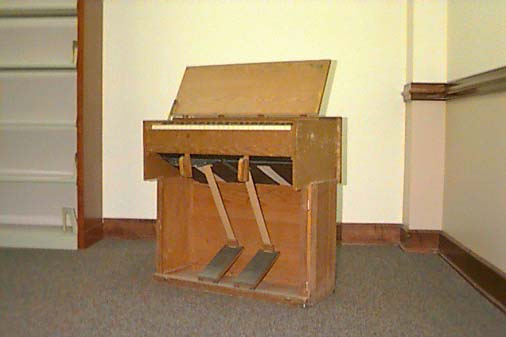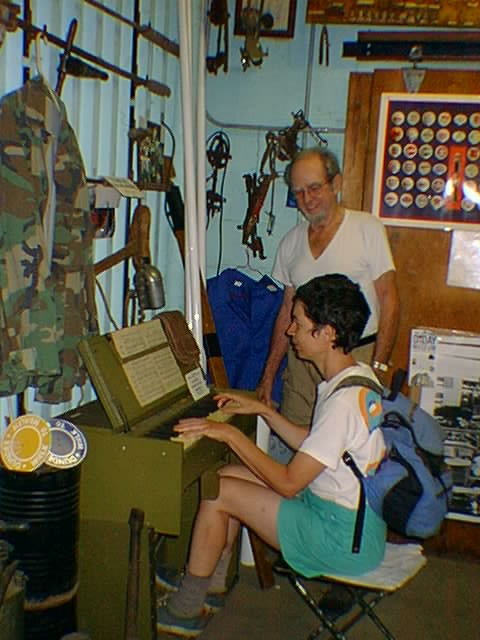Notes from Sandra Dodd on Chaplains' Organs
I have a portable Estey Organ and thought at one time it was a Chaplain's Organ. I've learned since that it's not, but that didn't stop my interest in Chaplain's Organs, so some of what I've learned and seen is here:
What's in the box below is lifted whole from another site. I've brought it here and changed the links so they'll still work, because I don't want to lose that page! I have an organ like this. Mine is in better shape, and I'm going to collect what I learn about it here
Material History of American Religion Project
Traveling organ

This object was found during the renovation of the library at
Columbia Theological Seminary. The library staff knows nothing about the history of this
portable reed organ, but they speculate it was used by an itinerant evangelist either in
the U.S. or overseas. It was manufactured by the Estey Organ Company of Brattleboro,
Vermont. An expert dates the organ to c. 1939, but Estey built similar models up through
the 1950s.
The organ case is solid oak. Folded up, the organ is twenty inches high, twelve inches
deep, and thirty inches wide, and can be carried by one (strong) person. It has four
octaves and two ranks of reeds, one at eight foot pitch and one at four foot. Each rank
has forty-nine notes. The left knee pedal brings on the four foot reeds, while the right
increases the volume. The organ is powered by two foot-operated bellows; our left bellow
has a hole, but still manages to supply some wind. The right bellow functions well..
Whoever used the organ must have seen it as essential to Christian worship. In the
early nineteenth century primitivist preachers decried the use of musical instruments in
worship as unbiblical and worldly. By the middle of the century, however, more churches
were using organs, and many Christians found that the sound of an organ turned any secular
space into a church. The preacher or evangelist who carried this heavy object on his (or,
less likely, her) rounds must have seen it as central for leading worship.
We are grateful to Paul Toelken, an Estey expert, who visited this page and filled in
the gaps in our knowledge.
Return to the objects page
Return to the project home page
|
Chaplain's Organ at the Dundee Motor Pool Museum
I found the following account and photo in an online travelog by Cynthia (Sindi) Keesan, http://keesan.freeshell.org/aug02b.htm
 "Tuesday, after we had breakfast together, Mike gave us a quick driving tour of Dundee, and then we stopped at his Dundee Military Pool Museum. We could not possibly have picked more interesting or kinder people to ask directions of the night before. Betty, who once worked as a military nurse, even baked up a batch of oatmeal cookies to send with us. (They did not last long).
"Tuesday, after we had breakfast together, Mike gave us a quick driving tour of Dundee, and then we stopped at his Dundee Military Pool Museum. We could not possibly have picked more interesting or kinder people to ask directions of the night before. Betty, who once worked as a military nurse, even baked up a batch of oatmeal cookies to send with us. (They did not last long).
"Mike is a retired owner of a stamping mill that used to be run on a cooperative profit-sharing basis. He has gradually converted it to an unexpectedly wonderful private museum of guns and other things he collects . He started by stamping reproduction antique rifle parts, and civil war belt buckles. Both sides wore the same buckles with different lettering. Then his antique Jeep collection expanded into antique military vehicles and took over the entire plant. The place is huge and we had a private tour. I got to play the portable chaplain's organ. The museum is open Wednesdays to the general public. It subsists on donations of other people's collections (including arrowheads, armor, and various vaguely related items) and money and is a real rival to Henry Ford's collection. All it needs is someone with a lot of time to write up tags for all the objects. We could have spent a few days in there. Unfortunately our camera did not take very good indoor photographs. Go see the museum itself and hear Mike's stories, both worth far more time than Cabella's.
"Mike volunteered before WWII started, and ended up, because of his ethnic German background, as an interpreter. He told us how some of the German soldiers were only 14 years old and had no training of any sort. Prisoners of war who were sent to the US during the war often stayed here and married. Mike's WWII interests have been growing since he attended a 50th anniversary of D-Day in Europe. He still has his original uniform."
Dundee Motor Pool Museum, photos on the site of the Patriot Riders Motorcycle Club. This is interesting to me, because the song they chose is "Dock of the Bay." My dad, Kirby Adams, left Rotan, Texas when he was in his mid teens, to work in the shipyards in San Francisco or Oakland, at the beginning of WWII. He joined the service early, with his parents' signatures. He was on a troopship on the way to Germany when the war ended. He served in the occupation, came home, married my mom, re-joined the army and was stationed in Arkansas where he was teaching people to drive and maintain vehicles. I don't remember if he said he rode a Harley to Oakland or bought one when he was there, but when I was little (in the mid 50's) he had a Harley 74 he fixed up and had for a while. I started this page to cite the pump organ, not knowing it would connect to my life in other ways.
Estey Organ Museum site  Photo Gallery of Reed Organs of the Reed Organ Society
Photo Gallery of Reed Organs of the Reed Organ Society

(one of the images the Reed Organ Society has collected)
Estey Folding Chaplain's Harmonium Photos and description by Jef Raskin whose site also links to this song performed on such an organ, uncredited (I'd love to credit whoever created the file) Listen in a separate window you can downsize
Connections
 Sandra Dodd Home
Sandra Dodd Home

 "Tuesday, after we had breakfast together, Mike gave us a quick driving tour of Dundee, and then we stopped at his Dundee Military Pool Museum. We could not possibly have picked more interesting or kinder people to ask directions of the night before. Betty, who once worked as a military nurse, even baked up a batch of oatmeal cookies to send with us. (They did not last long).
"Tuesday, after we had breakfast together, Mike gave us a quick driving tour of Dundee, and then we stopped at his Dundee Military Pool Museum. We could not possibly have picked more interesting or kinder people to ask directions of the night before. Betty, who once worked as a military nurse, even baked up a batch of oatmeal cookies to send with us. (They did not last long).